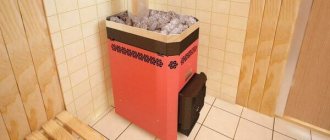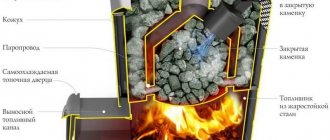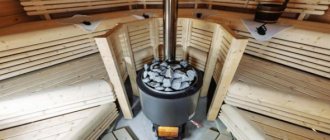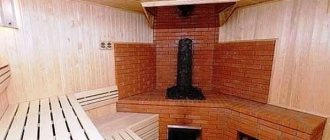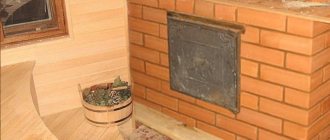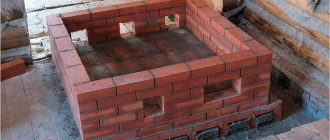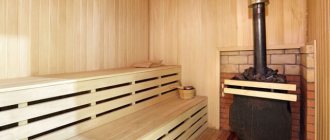A durable and original alternative to a purchased cast iron stove will be a stone version, built with your own hands, the so-called heater stove.
The laying process requires a lot of effort and experience, time and money, but such a stove will serve for decades.
It will not lose its functional properties or attractiveness. You can order its masonry, but it will be much cheaper to do everything yourself by looking at the available arrangements of brick sauna stoves.
How to calculate the optimal stove size
To determine the requirements for the size of the furnace structure, it is necessary to know the heat loss of the room. For example, you can take the street temperature to be -30 degrees, and in the house you need to get +18 degrees. The amount of heat loss takes into account the external volume of the house, since it needs to be heated completely, and not just some rooms. Sometimes the structure is planned to heat only one part of the bathhouse. In this case, it is recommended to count the cubic capacity of only this part.
To warm up one cubic meter, 21 kcal is required. To determine the total energy, you need to multiply it by the volume of the room. If it is equal to 200 m³ (10 meters long, 10 meters wide and two meters high), then the total heat loss will be 200 × 21 = 4,200 kcal. From this it is clear that the installed structure must provide the room with heating of 4,200 kcal. If it is less, then the heat will not be enough.
After obtaining the amount of heat loss, the parameters of the furnace structure can be determined. The meaning of “mirror” is usually used for this. It is equal to the product of its perimeter and height without taking into account the chimney. Every 1 m² of fire gives off 300 kcal of heat. From this it turns out that a mirror for heating a room of 200 m³ should have an area equal to 4,200/300 or 14 square meters.
Next, determine the height, length and width of the stove. Typically, the active height is used as the height, which is equal to its normal height from the floor minus 30 centimeters. In this example, a value of 2.2 meters will be used. This means that the perimeter of the mirror is 14 / 2.2 or 6.36 meters. It is two widths and two lengths of the stove, so their sum is 6.36 / 2 = 3.18 meters. This is the size of the base of the future masonry. For example, if the length is 2 meters, then the width will have to be 1.18 meters. Further, everything is individual and depends on the room and the desired installation location.
If the bathhouse has a small area, then a stove measuring 3 by 4 blocks will be enough. Square shapes with dimensions of 4 × 4 and 6 × 6 bricks are also popular.
Preparing the wall surface for putty
The main thing is to make sure that the surface of the walls is absolutely clean. Be sure to remove stains of grease, paint or soot. Of course, there should be no falling layers of plaster, residues of scale, wax or parts of the formwork. Don’t even start puttingty on frozen ceilings and walls. This is strictly not recommended.
Before applying putty, coat the walls with a primer. This will ensure good adhesion (connection) of the putty solution to the walls. Prime the surface using a special roller. Try to apply the primer solution evenly, avoiding gaps. One layer is enough.
Ways to increase furnace efficiency
Achieving the best performance indicators of the stove, as well as increasing the efficiency of its use, is possible only with complete combustion of the fuel. If the firewood is on the grate, then the primary air flow will pass into the equipment from below through the grate from the ash pit. Its main purpose is to oxidize the fuel to release water vapor as well as carbon dioxide. As the fuel temperature increases, the release of flammable gases increases. They burn in the upper space directly above the firewood, forming carbon monoxide.
To increase the efficiency of a heater stove for a brick bath, it is necessary to ensure complete combustion of the gases in the fuel compartment. To do this, organize an additional air flow through the cracks in the firebox door. If there is no secondary air, the wood will not burn completely, and a lot of soot will settle on the stones. Because of this, heat transfer will significantly decrease and the risk of fire spreading will increase.
A brick sauna stove with an open heater can also increase its efficiency as follows:
- Increase in coolant (stones).
- Expanding the heating surface area.
- Reducing wall thickness during the construction phase.
It is worth understanding the dependence of the size of the firebox on the consumption of firewood or other fuel. The larger the volume of the combustion chamber, the greater the fuel consumption will be. At the same time, heat transfer will also increase.
Brick heater stove: how to reduce heat loss
The most common way to reduce heat loss is based on laying trench channels in the lower part of the stove (at the same level as the ash pan). This must be done at the laying stage.
Trenches are blind channels, the purpose of which is to reduce the interaction of the bottom of the unit with the floor, foundation and basements. They contain an air layer inside, which acts as a thermal insulator.
In addition, trench channels can improve the convection of air masses in the most problematic place of the furnace - the lower part. The heat from the firebox falls down, and the channels distribute it throughout the room. This avoids heat accumulation in the lower part of the stove.
Heat transfer can be increased not only with trenches, but also with cast iron pipes that are laid inside the unit. Empty pipes will heat up and warm the air masses. The result will be a primitive heater.
What is the difference between a Dutch woman and a Swedish woman, I confuse them
The Dutch oven was created specifically as a heating stove, but now they are making a hob in it. This device is much simpler than a Russian stove: a combustion chamber with a labyrinth of smoke ducts on top. The smoke travels along this winding path for a long time, and thanks to this the heat does not escape. In our country, Dutch was traditionally decorated with tiles - this option is considered a classic.
The Swedish stove is an improved version of the Dutch stove with a vertical system of smoke circulation channels. Swedish scientists optimized it in the mid-18th century by expanding the lower part and adding an oven to the side.
The Swedish oven is the result of careful calculations. With its quite compact size, it warms up quickly, allowing you to cook food, heat the house, etc. The efficiency of the Swedish stove is slightly inferior to that of the Russian stove, but this design requires precise calculations. They drown the Swede twice a day.
Kamenka - a feature of the stove for a Russian bath
This type of structure is easier to erect than others, but before laying it is recommended to draw a diagram with the planned dimensions. Based on it, it will be clear how much materials are needed and where it is better to install the heating system.
This design consists of three zones. These are the most important elements of the system. The lower one is the firebox, then the heater, and above it there is a water tank, if it was originally planned. The peculiarity of the heater is that it is able to warm up even a large room, enriching it with warm and soft steam, as well as hot water when installing the tank.
Water container
Immediately before building the stove, it is important to determine the volume of the tank in which the water will be heated. The volume of the tank will depend on the intensity of visiting the steam room
So, the calculation is made based on one liter of hot water per person. It is best to use an open container. Although there will be evaporation, there are a number of positive aspects:
- Convenient when filling the container.
- The ability to carry out maintenance or repair of the internal part if necessary, for example, remove scale, clean and dry.
- In winter, completely remove water, protecting the tank from freezing the water in it.
What kind of stove to build in a bathhouse
A sauna stove can have different dimensions, which will depend on the area of the heated room. Most often, people build stoves measuring 3.5 × 4 or 4 × 5 blocks. The height reaches 168 centimeters or 210 centimeters, respectively. The second type is suitable for small steam rooms with a high ceiling.
Preference should be given to a brick stove with a water circuit, which is a tank for heating water.
The designs of such devices are almost identical. The functionality remains the same. Only the appearance and location of the tank changes. Stoves with lower and upper water tanks received recognition. A brick sauna stove with an open container for stones is also popular, but it pollutes the air with soot and requires the wood to burn out completely in order to fill the stones with water.
Can a fireplace be installed in any room of the house or are there restrictions?
There are a lot of restrictions. It is not allowed on the second floor (usually the ceilings are not designed to support the weight of even a small fireplace), in a regularly shaped room with an area of at least 20 square meters with three-meter ceilings, so that the volume of air is sufficient for normal combustion. But a fireplace that is too small will not be able to heat a large room. For masonry fireplaces there is a rule:
area of the combustion window = 1/50 of the area of the room.
The firebox window should “look” into the middle of the room.
Types of brick stoves for baths
A sauna stove with a closed brick heater is one of the most important attributes of a Russian sauna. It is often classified according to the combustion method:
- In black . Such stoves appeared before everyone else. They did not have a chimney, and the smoke accumulated in the room, blackening the walls or objects with soot. We had to wait for the firewood to completely burn out and ventilate the bathhouse through a window or door.
- In gray. The stove has a chimney, but its container with stones is open. It warms up the room faster, but the soot settles on the stones. Because of this, you also have to wait for complete burnout.
- In white . These are stoves with a closed container and a chimney. It does not pollute steam room walls or stones. The design retains heat better than others. From the open type the steam is hot, “hard” and scalding, but from the closed type it is comfortable and pleasant even at one hundred degrees Celsius.
Another convenient division of stoves is also based on the combustion method. They are:
- Periodic action. The stones are above the flame or in direct contact with it. You can water them only after the firewood has completely burned out, as there is a risk of flooding them. Such stove systems are heated periodically.
- Permanent action. The stones are placed in a closed container. Most often it is a metal or cast iron container. Because of this, heat transfer suffers slightly, but you can pour water on them throughout the entire firebox. Such a stove is heated when there are people in the bathhouse. This is not harmful, since combustion products do not enter the air.
A directly heated brick sauna stove, unlike a closed type, does not allow achieving the most pleasant temperature or air humidity, and also requires periodic operation.
With or without blower
First you need to understand what a blower is. It is a special air channel that passes masses of gas under the grate and into the firebox. This is necessary so that the firewood or other fuel is regularly supplied with oxygen. To regulate traction? doors are used.
You can install a stove without a vent with a solid floor. This does not mean that there will be no air circulation at all: masses will penetrate from the combustion door, but it is too large to finely regulate the flow.
As a result, the efficiency will decrease, and burnt coals will sometimes fall out of the combustion chamber, which is also unpleasant, especially if the floor is covered with wood. The optimal solution remains to lay a blower.
Open heaters
In an open heater, the stones are placed openly. They lie on top and come into contact with the air masses of the steam room. This type is typical for compact cast iron or steel fixtures for small cubic capacity baths. Due to their location, stones or cast iron chocks quickly heat up and transfer their heat to the bathhouse. Lighting up a room takes from 30 minutes to one hour. This method also has a drawback: the stones also cool quickly.
In this case, to generate steam, use a container of water, which is poured over the stones. The steam is hot, “hard” and scalding. If the thermal elements are not on the plate, and not on the grate, then soot will settle in the room, and the water will extinguish the firewood and prevent it from burning properly. The main advantage of this design is the speed of heating and ease of implementation of the circuit.
Closed heaters
The design is more complex in its structure. In it, the stones are placed in a special compartment located inside the oven. During heating, they do not come into contact with the room air and you have to wait longer to warm up the steam room. This takes about a couple of hours, but it all depends on the size of the oven and sauna.
The advantage of this type is a longer heat release, which means that after waiting a little, you can enjoy the procedures all evening.
In the closed type, a tank or container with water is located near the heater itself, so the steam coming out of it has a maximum temperature, since the gas expands in volume. It is soft, and its heat is practically not felt even by an unprepared person.
What does it represent?
This version of the stove is used if you need to operate the bathhouse all day and for several people. This type of design quickly heats up the steam room. It has good heat capacity, dry air, heat close to 90 degrees, pleasant appearance from the outside, neat proportions. It is better to build a bathhouse of this type in small rooms up to 25 square meters. m, since huge spaces are difficult to heat to the required temperature. The size of the stove is often 77 by 77 cm to heat a space of 3 by 3 meters. The approximate quantity of bricks required for this size of oven is 290 pieces. The design includes a metal boiler for water and an open niche for stones with a volume of up to 120 kg.
What is needed for the construction?
To lay a stove of this kind, a minimum amount of skills and materials is required. The only thing that is required is conscientiousness in work, basic knowledge about laying a stove, some bricks, and various types of accessories for the stove. The pebbles are placed on a grate above the fuel chamber, but the sequence must be observed: some of the largest samples should be at the bottom, and smaller ones at the top. If you overdo it a little and attach a galvanized lid, you can cover the stones with it after heating to a certain temperature. This will help keep the heater longer in hot weather.
Ordering a closed heater stove for a bath
It is better to describe the order of a closed heater in more detail. The instructions look like this:
- The first rows are laid perfectly flat. It checks the verticality of the angle using a level.
- An ash pit is made that will collect waste from fuel combustion.
- In the third row, the blower is attached from a steel or cast iron strip.
- Above the fifth row, steel corners of the grate are laid.
- They put down the firebox.
- The sixth row is laid out with fireclay blocks. The total height of the chamber will be about 25 centimeters and the width – 30 centimeters.
- Lay the grate.
- Expand the firebox area in the following rows.
- Make holes for an additional air duct.
- The outer brick is laid.
- The firebox doors are blocked.
- Install the chimney partition.
- Insert the water tank.
- On the 15th row, they begin to cover the firebox with a special slab on which stones will be laid.
- Lay out a compartment for laying stones.
- Lay out a chimney from a fireclay block, which tapers towards the top.
After construction, the surface must be dried for seven days. You cannot use the device right away, as moisture contributes to faster failure of the furnace system or foundation.
.
Characteristics and nuances of a brick stove for a bath
Water treatments bring joy to everyone. To heat a room, a sauna-stove made of brick is often used. Any stove has the following characteristics:
- Type of construction. As has already become clear, there is an open and closed type.
- Design. The system may consist of a chimney, grate, firebox, as well as other elements that are characteristic of a particular type.
- Weight. The indicator depends on the size of the stove and the volume of its firebox part. The greater the weight of the unit, the more reliable the base should be.
- Fuel. The stove can be powered by wood, coal, gas or electricity.
- Dimensions. Usually they depend on the volume of the bath. Most often, units measuring 4 by 3.5 or 4 by 5 blocks are installed.
The need to shield the walls
In addition to the fact that a closed heater is required, it is also important to shield the flow of hard radiation coming from the metal walls. A number of manufacturers create double metal casings around the unit body that reduce convection.
In addition to the fact that a closed heater is required, it is also important to shield the flow of hard radiation coming from the metal walls. A number of manufacturers create double metal casings around the unit body that reduce convection.
We suggest you find out at what temperature the solution can be poured
For the same purpose, cladding with natural minerals can be used. Similar stoves are offered by many manufacturing companies, but since natural finishes are very expensive, the products cannot be called cheap.
Basic requirements for brick stoves with heaters
A stone stove is one of the most important elements of a Russian bath, therefore a number of requirements are put forward for it:
- Carbon monoxide or smoke must not enter the room in which the unit is located.
- Warming up the air under the ceiling to 90+ degrees in a short period of time.
- Economical.
- A design that allows heated stones to retain heat for as long as possible.
- Dimensions that allow you to easily place the stove even in a small bathhouse.
An open type of container with water is well suited for a Russian bath, since it is easier to care for, and the liquid can be drained for the winter.
Fire safety measures
- Maintain a distance from the firebox to the stove surface of at least 50 cm.
- When installing the pipe, a gap of 10 cm is provided to the wooden components of the roof.
- If the structure is located near a wall, a distance of 10-15 cm must be maintained.
- The pipe above the roof surface should rise 50 cm or more. Otherwise, due to insufficient draft, the stove will smoke and burn poorly.
- A steel sheet is laid on the wooden floor in the bathhouse on the side of the fire door so that falling coal does not set the entire structure on fire.
Advantages and disadvantages of a heater for a brick bath
Most people use stone elements as a heating bath system, and this is for a reason. Such designs have a number of advantages:
- Energy independence. If there is no gas or electricity in the house, then a heater will be the optimal solution for heating a bathhouse.
- Comfort. The stove produces soft, warm steam that warms rather than burns.
- Heat capacity. Ability to retain heat for a long time.
- Economical. It does not require much fuel to heat the entire room. Can run on wood.
- Fire safety. A structure made in accordance with all fire safety standards almost never becomes a source of fire.
- Appearance. Each person can bring something different to the design or decoration.
There are also disadvantages. Among them:
- Requirement for care.
- Difficulty of construction.
- Dimensions.
- Time to kindle.
- High cost of the entire project.
Construction of a brick sauna stove: sequence of work
It's time to briefly consider the sequence of work during the construction of the system. Any such unit is individual, as it is built according to a pre-drawn plan. This is what you should think about first. Most often, the design and dimensions of the future stove are taken into account in the design of the bathhouse itself.
If a person has chosen the design and its dimensions, then work can begin. To do this, the very first thing to do is pour the foundation. It is also advisable to think about it in advance, since then you will have to cut the joists and rafters. The base for the stove must be strong, multi-layered to prevent heat from escaping into the floor, as well as the spread of dampness.
After this, a solution is prepared. Usually it is a mixture of clay and sand, since cement does not tolerate high temperatures. It is best to use fireclay clay soaked for a day. It is advisable to sift the sand for the solution. The work stage involves completing the order, and then the oven must dry.
Selecting materials for constructing an open stone stove
Typically, two types of bricks are used for construction:
- Red full-bodied. They are needed for the outer layer and decoration. For an average oven, 300 pieces are enough, and for a large system - about a thousand.
- Fireclay. Sturdy fireproof blocks that can heat up to 1,400 degrees. Often used only for laying out the fuel compartment.
The quality of the bricks can be checked by tapping them with a trowel handle or a hammer. If the sound is dull, then most likely the bricks have flaws or are defective.
In addition to bricks you will need:
- Clay-based solution with sand.
- Thermal insulating materials.
- Cast furnace elements.
- Tools for performing work.
Rules for successful masonry
The efficient operation of the furnace largely depends on how well the masonry technology was followed. This is influenced by the quality of the bricks, the method of doing the work, the binding solution and the degree of moisture of the material. The result of proper masonry will be a solid structure. An unsatisfactory result is considered to be a structure made without bandaging the joints, separated by vertical lines of seams.
During the work, one important requirement must be met: it is necessary to prevent the gases formed during combustion from escaping to the outside. In addition, air entering the furnace structure is also not welcome.
Careful selection and adjustment of the material will help make the masonry beautiful and durable. It is important that the bricks are split and hewn. Before starting work, the cobblestones need to be soaked in water, lowered into a container for 10 seconds, then laid in a row on a layer of clay.
Craftsmen advise applying the mortar by hand, and using a trowel only when doing external masonry.
The brick laying process is as follows:
- take the block in one hand, grab the clay with the other and apply a thin layer to the brick;
- level the surface;
- place the product in a specific place;
- while pressing on the cobblestone, perform forward and backward movements;
- remove excess mortar on both sides of the masonry with your hands;
- with the next brick, repeat the above steps, in this case it is necessary to apply the solution also to the end of the block, with which it will be pressed against the first one.
Brick stove for a bath with a closed heater: arrangement of a water heating tank
Sometimes a water heating tank is included in the design of a closed heater. This allows you to quickly get a lot of hot water, saving money and time. Tanks can be built-in or wall-mounted, but they must be installed in such a way as to consume the maximum amount of heat.
Usually the volume is calculated based on the rule: 20 liters per person.
A tank is an optional attribute, but it will be useful for those who have problems with hot water supply. This is a very relevant addition for village baths.
The main thing is to take into account a number of points. In order for the stones to begin to emit light steam, they must warm up to at least 300 degrees, and the water will begin to boil from the 100 mark and will not heat up anymore.
This means that you cannot place the tank next to stones, as it will cool them down.
There are three solutions to the problem.
The first is to separate the tank and stones into different sections.
The second is based on installing a tank above the stones, which gives them the opportunity to first warm up themselves and then begin to heat the liquid.
The third option involves heating water using a coil located inside the firebox, but such designs are more complex and more expensive.
Steam gun
The operation of a closed heater depends on how isolated it is from the walls of the unit and the state of the air in the steam room. The better these indicators are, the hotter the stones will be able to heat up. However, in this case there is a problem with how to supply water to the stones.
In order to obtain steam inside the heater, a system of tubes with holes is installed. A glass or funnel is attached to the outside and water is poured in. It flows down the tube down the unit. Such a device is called a heat gun. It got its name because the escaping steam makes loud sounds, reminiscent of a gunshot.
When using this device, it is recommended not to limit yourself to a single tube - it is better to make a branched version at the bottom, which will evenly distribute the liquid throughout the stove and bring it to the hottest zones.
The operation of a closed heater depends on how isolated it is from the walls of the unit and the state of the air in the steam room. The better these indicators are, the hotter the stones will be able to heat up. However, in this case there is a problem with how to supply water to the stones.
Brick stove with a closed heater for a bath and with open stones - finishing features
Finishing allows you to give the stove a beautiful and unique appearance.
Typically, tiles, stone, bricks, steel, tiles and other materials are used for cladding. The choice is quite wide, but each material has its own characteristics and properties.
If it is prepared independently, then initial processing must be performed so that the material can withstand high temperatures.
Stove tiles have the properties of thermal expansion, therefore, when using them, it is necessary to strictly follow the technological processes of masonry, since the cladding does not tolerate negligence. The most commonly used types are: terracotta, clinker tiles, majolica, tiles, porcelain stoneware, fireclay and tiles.
It is preferable to use tiles, but at the same time the process of laying them is the most labor-intensive. Even using simplified technology, you will have to spend more than one month to complete the finishing. A budget option is fire-resistant tiles, but even these cannot be used in the hottest areas of the structure.
Brick is a traditional material for cladding. It is not only suitable for laying near wooden walls located in close proximity to a heat source, but also accumulates heat well. Typically, ordinary ceramic blocks, fireclay and silicate bricks are used.
Modern designers love to use stone to decorate interiors and cladding stove walls. Finishing with such material is not difficult, but you need to choose the right stones so that they do not crack and serve as additional heat accumulators. The choice should be made on natural stones such as serpentinite and jadeite or artificial analogues. Representing the same tiles with irregularities, executed in a chaotic form.
Photos of brick stoves for baths
Model with tank
Cast iron option
Open type stone oven
Plastered stove stove in the bathhouse
Materials for the stove: what and how much
Now about the materials. Masonry should be done with bricks, but not ordinary ones, but heat-resistant ones. The thing is that ordinary blocks can overheat and crack, but fireproof ones will accumulate heat and keep it inside themselves. Typically, fireclay and red solid bricks are used for masonry. The first one is quite expensive and is used only for laying out the firebox, but some people buy it for the construction of the entire furnace system. The second is to lay out all the other elements, including the chimney. It is less expensive, but cannot withstand extremely high temperatures.
You also cannot do without masonry mortar. It is made only from clay and sand, but some craftsmen add cement, table salt or heat-resistant glue to it to increase its strength characteristics. Only cement will not work, as it will crumble and collapse.
A heat insulator is also needed to prevent heat from spreading to flammable surfaces (wooden walls, benches, floors). Usually it is finished with tiles or an additional layer of stones.
The heater also requires stove casting elements, since doors, grates, water tanks and coils cannot be made from stones. Usually they are purchased in advance, determining the dimensions according to the structure diagram and its dimensions.
Final finishing of the stove
Everything is clear about finishing materials. In addition to tiles, you can use plaster, whitewash, painting and decorative heat-resistant clay. This will help decorate a boring stove and make it stand out against the background of the interior of the bathhouse. Finishing with tiles or other materials is necessary only after the mortar fixing the stones has completely hardened.
A stone stove is the most popular attribute of a Russian bath. Recently, people have begun to prefer building it themselves. It's much cheaper than ordering estimates from unknown people. Manual construction also allows you to give the stove an individual style and shape of the structure.
We mount it correctly
High-quality steam, a heated and safe room can be obtained if you adhere to the following recommendations:
- the blower should be located on the exit side, and the heater door should be on the opposite side;
- a metal closed oven is installed on a prepared base;
- safety is achieved by isolating all flammable materials (you can use a layer of clay);
- the chimney is plastered in places where it passes through the ceiling;
- the pipe must exceed the roof structure by 0.5 meters.
Taking these subtleties into account, a high-quality and safe sauna stove is created.

